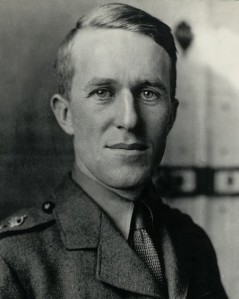Biggles Meets the Sandman August 19, 2010
Author: Beach Combing | in : Contemporary , trackback
Beachcombing offers a post today on an unlikely WIBT meeting between two writers: T.E. Lawrence and W. E. Johns.
Lawrence should need no introduction. He was a British lieutenant colonel who helped foment the Arab Revolt against the Ottoman Empire (1916-1918). And with a self-publicising genius and an extraordinary pen he romanticised his role in that war in the Seven Pillars of Wisdom, a minor classic.
A hero to many he was also a difficult person with almost unbounded conceit. After the First World War he wished to escape from the world and live anonymously, yet he was constantly galled that people had the impudence not to recognise him.
W.E. Johns, on the other hand, does need an introduction as his works are less read than they once were. A First World War pilot, he authored, from 1922 to 1968, a series of children books, the most famous about an air pilot, Biggles: in fact, 98 Biggles volumes were written before the series petered out.
A down-to-earth, likeable rather bluff fellow, Johns was the polar opposite of prickly Lawrence. And yet in August 1922 they collided.
In that year Johns was still in the Royal Air Force but working now as a recruiter rather than a pilot: Johns managed to write off three planes in three days in 1917!
It was his bad luck that in his role as RAF recruiter a tall, thin man walked into his office and announced an interest in joining the service. His name, the newcomer claimed, was John Hume Ross: in fact, this was T. E. Lawrence trying to be inconspicuous.
Johns later remembered ‘that I took an instant dislike to [Ross]. I had got to know the type. He was ‘different’ from other recruits and he was letting me know.’ This dislike was then justified when Johns discovered that John Hume Ross’s references and details did not check out – they were fabrications.
Johns, of course, turned down the mysterious and irritating ‘Ross’. But ‘Ross’ then returned with an official from the Air Ministry who demanded, on the highest authority, that ‘Ross’ be taken on and Johns had no choice but to comply.
Lawrence had friends high up in the Air Ministry, including Sir Oliver Swann who would back him to the hilt. And the hero of the Arab Revolt had decided that the RAF would give him a sanctuary. There may have been something to this as he remained in the service, until 1935, the year of his death, with only some very brief interruptions.
Beachcombing finds something deeply satisfying about this meeting and after an hour in the bath he has worked out what.
Lawrence was a flawed and perhaps even an unpleasant individual. He had many unusual tastes including a love of flagellation – whip marks on his back were noted by the RAF doctor in 1922. Then his politics easily veered away from decent conservatism towards intolerable totalitarianism in the 1930s.
Yet he was idolised by a whole class of Empire Colonel Blimps – Johns, in many ways, epitomised that class – who saw him as ‘a man of destiny’ and had an altogether unrealistic idea of their hero.
(This is brilliantly summed up in Lean’s 1962 film Lawrence of Arabia by the non-commissioned officer who takes exception to Allenby’s words after Lawrence’s funeral.)
Johns had the fortune to come face to face with ‘the man of destiny’ and saw through his disguise. As a result Biggles never had to fly to the succour of a blond British hero in the sands of Syria. For this Beachcombing is properly grateful.
Beachcombing would love to learn more about this meeting: drbeachcombing AT yahoo DOT com



